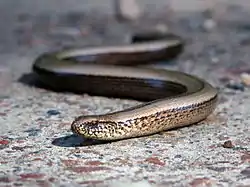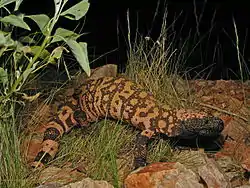Neoanguimorpha
Los neoánguimorfos (Neoanguimorpha) son un infraorden de lagartos escamosos ánguimorfos que comprende desde Heloderma hasta Diploglossa (Xenosauridae, Diploglossidae, Anniellidae y Anguidae).[1][2][3][4][5] Los estudios morfológicos antiguos habían clasificado a los helodermátidos con los varanoideos en el clado Platynota.[6][7] El lagarto cocodrilo chino fue clasificado erróneamente como un xenosáurido.[8] Sin embargo, el trabajo molecular no encontró apoyo en estas agrupaciones y, en cambio, encontró que los helodermátidos están más relacionadas con Diploglossa, mientras que el lagarto cocodrilo chino y los varanoides forman el infraorden hermano Paleoanguimorpha.[2][3]
| Neoanguimorpha | ||
|---|---|---|
| Rango temporal: Albiense – Presente, 105 Ma - 0 Ma | ||
 | ||
 | ||
| Taxonomía | ||
| Reino: | Animalia | |
| Filo: | Chordata | |
| Clase: | Sauropsida | |
| Orden: | Squamata | |
| Suborden: | Anguimorpha | |
| Infraorden: |
Neoanguimorpha Vidal & Hedges, 2009 | |
A continuación se muestra la filogenia de los linajes de los neoánguimorfos según Pyron et al. (2013):[3]
| Neoanguimorpha |
| ||||||||||||||||||||||||
Referencias
- Fry, Bryan G.; Vidal, Nicolas; Norman, Janette A.; Vonk, Freek J.; Scheib, Holger; Ramjan, S. F. Ryan; Kuruppu, Sanjaya; Fung, Kim et al. (2006-02). «Early evolution of the venom system in lizards and snakes». Nature (en inglés) 439 (7076): 584-588. ISSN 1476-4687. doi:10.1038/nature04328. Consultado el 10 de abril de 2022.
- Vidal, Nicolas; Hedges, S. Blair (1 de febrero de 2009). «The molecular evolutionary tree of lizards, snakes, and amphisbaenians». Comptes Rendus Biologies. La théorie de Darwin revisitée par la biologie d'aujourd'hui / Darwin's theory revisited by today's biology (en inglés) 332 (2): 129-139. ISSN 1631-0691. doi:10.1016/j.crvi.2008.07.010. Consultado el 10 de abril de 2022.
- Pyron, R. Alexander; Burbrink, Frank T.; Wiens, John J. (29 de abril de 2013). «A phylogeny and revised classification of Squamata, including 4161 species of lizards and snakes». BMC Evolutionary Biology 13 (1): 93. ISSN 1471-2148. PMC 3682911. PMID 23627680. doi:10.1186/1471-2148-13-93. Consultado el 10 de abril de 2022.
- Zheng, Yuchi; Wiens, John J. (1 de enero de 2016). «Combining phylogenomic and supermatrix approaches, and a time-calibrated phylogeny for squamate reptiles (lizards and snakes) based on 52 genes and 4162 species». Molecular Phylogenetics and Evolution (en inglés) 94: 537-547. ISSN 1055-7903. doi:10.1016/j.ympev.2015.10.009. Consultado el 10 de abril de 2022.
- Wiens, John J.; Hutter, Carl R.; Mulcahy, Daniel G.; Noonan, Brice P.; Townsend, Ted M.; Sites, Jack W.; Reeder, Tod W. (23 de diciembre de 2012). «Resolving the phylogeny of lizards and snakes (Squamata) with extensive sampling of genes and species». Biology Letters 8 (6): 1043-1046. PMC 3497141. PMID 22993238. doi:10.1098/rsbl.2012.0703. Consultado el 10 de abril de 2022.
- McDowell, S.B.; Bogert, C.M. (1954). "The systematic position of Lanthanotus and the affinities of the anguinomorphan lizards". Bulletin of the American Museum of Natural History. 105: 1–141.
- Lee, Michael S. Y. (29 de enero de 1997). «The phylogeny of varanoid lizards and the affinities of snakes». Philosophical Transactions of the Royal Society of London. Series B: Biological Sciences 352 (1349): 53-91. PMC 1691912. doi:10.1098/rstb.1997.0005. Consultado el 11 de abril de 2022.
- Bhullar, B.-a. S. (2011-12). «The Power and Utility Of Morphological Characters In Systematics: A Fully Resolved Phylogeny of Xenosaurus and Its Fossil Relatives (Squamata: Anguimorpha)». Bulletin of the Museum of Comparative Zoology 160 (3): 65-181. ISSN 0027-4100. doi:10.3099/0027-4100-160.3.65. Consultado el 11 de abril de 2022.